Pseuduvaria taipingensis is a species of plant in the family Annonaceae. It is a tree endemic to Peninsular Malaysia. James Sinclair, the Scottish botanist who first formally described the species, named it after Taiping a city in Perak, Malaysia where the specimen he examined was collected.

Pseuduvaria bruneiensis is a species of plant in the family Annonaceae. It is endemic to Borneo. Yvonne Chuan Fang Su and Richard M.K. Saunders, the botanists who first formally described the species, named it after Brunei where the specimens they examined were collected.
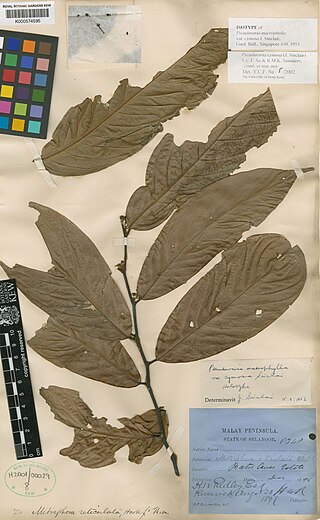
Pseuduvaria cymosa is a species of plant in the family Annonaceae. It is native to Peninsular Malaysia. James Sinclair, the Scottish botanist who first formally described the species using the synonym Pseuduvaria macrophylla var. cymosa, named it after its branched inflorescences which are called cymes.
Pseuduvaria dielsiana is a species of plant in the family Annonaceae. It is native to New Guinea. Carl Lauterbach, the German botanist who first formally described the species using the synonym Goniothalamus dielsianus, named it in honor of Ludwig Diels, another German botanist who also worked on taxa from New Guinea.
Pseuduvaria kingiana is a species of plant in the family Annonaceae. It is native to the Malay Peninsula. Yvonne Chuan Fang Su and Richard Saunders, the botanists who first formally described the species, named it after Sir George King, the British botanist who first collected the species.
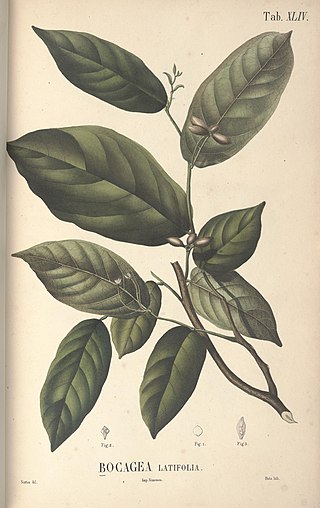
Pseuduvaria latifolia is a species of plant in the family Annonaceae. It is native to Java. Carl Ludwig Blume, the German botanists who first formally described the species using the synonym Bocagea latifolia, named it after its broad leaves.
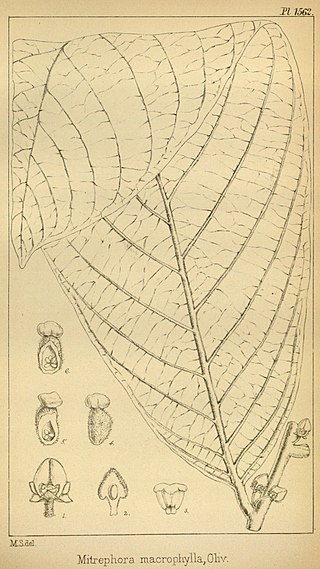
Pseuduvaria macrophylla is a species of plant in the family Annonaceae. It is native to Peninsular Malaysia, Sumatra and Thailand. Daniel Oliver, the English botanists who first formally described the species using the synonym Mitrephora macrophylla, named it after its large leaves.

Pseuduvaria megalopus is a species of plant in the family Annonaceae. It is native to New Guinea. Karl Schumann, the German botanist who first formally described the species using the synonym Petalolophus megalopus, named it after the large wings that extend downwards from the underside of the inner petals to form a foot of dark red tissue that resembles carrion and is thought to attract fly pollinators.
Pseuduvaria mindorensis is a species of plant in the family Annonaceae. It is native to the Philippines. Yvonne Su and Richard Saunders, the botanists who first formally described the species, named it after the island of Mindoro where the specimen they examined was collected in the municipality of Puerto Galera.
Pseuduvaria mollis is a species of plant in the family Annonaceae. It is native to New Guinea. Otto Warburg, the German-Jewish botanists who first formally described the species using the basionym Goniothalamus mollis, named it after the soft hairs on its leaves and petals.
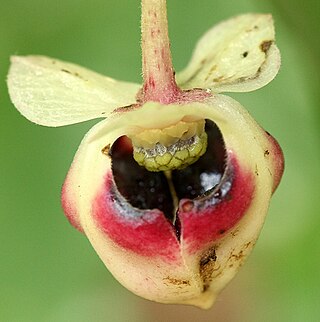
Pseuduvaria mulgraveana is a species of plant in the family Annonaceae. It is native to Australia. L.W. Jessup, the botanist who first formally described the species, named it after the Mulgrave River in Goldsborough, Queensland where the specimen he examined was collected.

Pseuduvaria multiovulata is a species of plant in the family Annonaceae. It is native to Myanmar. Cecil Fischer, the Indian botanist who first formally described the species using the basionym Mitrephora multiovulata, named it after its many ovuled ovaries.

Pseuduvaria guineensis is a species of plant in the family Annonaceae. It is native to New Guinea. James Sinclair, the Scottish botanist who first formally described the species, named it after New Guinea where the specimen he examined was collected near Kokoda.
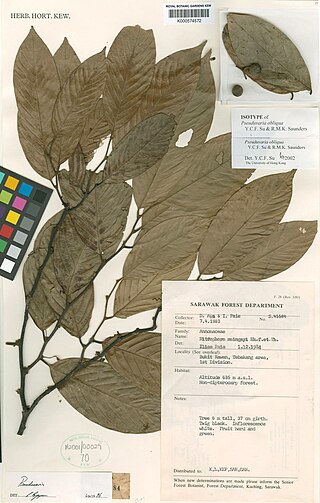
Pseuduvaria obliqua is a species of plant in the family Annonaceae. It is native to Borneo. Yvonne Su and Richard Saunders, the botanists who first formally described the species, named it after its slightly uneven leaf bases.
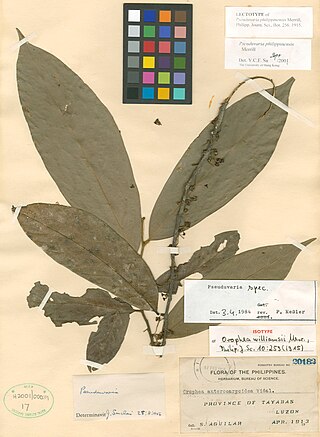
Pseuduvaria philippinensis is a species of plant in the family Annonaceae. It is native to the Philippines. Elmer Drew Merrill, the botanist who first formally described the species, named it after the Philippines where the specimen he examined was collected in the Province of Quezon.

Pseuduvaria rugosa is a species of plant in the family Annonaceae. It is native to Java, Laos, the Lesser Sunda Islands, Peninsular Malaysia, Myanmar, the Nicobar Islands, Sumatra and Thailand. Carl Ludwig Blume, the botanist who first formally described the species under the basionym Uvaria rugosa, named it after its wrinkled fruit.
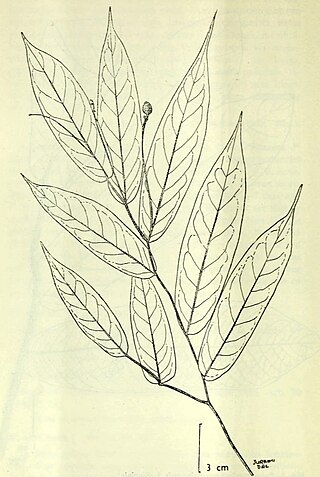
Pseuduvaria sessilifolia is a species of plant in the family Annonaceae. It is native to New Guinea. James Sinclair, the botanist who first formally described the species, named it after its stalkless leaves which lack petioles.

Pseuduvaria setosa is a species of plant in the family Annonaceae. It is native to Peninsular Malaysia. George King, the botanist who first formally described the species under the basionym Orophea setosa, named it after the bristly hairs on its leaves and petioles.
Pseuduvaria trimera is a species of plant in the family Annonaceae. It is native to China, Myanmar, Thailand, and Vietnam. William Grant Craib, the British botanist who first formally described the species, named it after its fascicles of flowers that often occur in three parts.

Pseuduvaria villosa is a species of plant in the family Annonaceae. It is endemic to Australia. L.W. Jessup, the botanist who first formally described the species, named it after its leaves and branchlets which are shaggy with long soft hairs.













